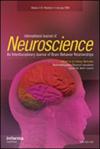17型脊髓角性共济失调与亨廷顿舞蹈症鉴别的困境:共病还是独立病?
IF 1.7
4区 医学
Q4 NEUROSCIENCES
International Journal of Neuroscience
Pub Date : 2024-12-01
Epub Date: 2023-10-31
DOI:10.1080/00207454.2023.2273766
引用次数: 0
摘要
亨廷顿舞蹈症(HD)和脊髓角性共济失调17(SCA17)突变都显示出CAG重复扩大,临床表现重叠:运动障碍、精神症状和认知障碍。因此,SCA17也称为亨廷顿舞蹈症样疾病(HD样,HDL)4型。在本文中,我们报道了一名患者在HTT基因中有47个CAG重复,在TBP基因中有42个CAG反复。在一名患者中,SCA 17与HD的鉴别存在困境,这在以前从未报道过。HD的诊断是与SCA17共病还是仅与HD共病?本文章由计算机程序翻译,如有差异,请以英文原文为准。
Dilemma in differentiation of spinocerebellar ataxia type 17 from Huntington's disease: comorbidity or independent disease?
Both Huntington's disease (HD) and Spinocerebellar ataxia 17 (SCA17) mutations showed expanded CAG repeats, with overlapping clinical manifestation: motor disorders, psychiatric symptoms and cognitive impairments. Therefore, SCA17 is also called Huntington like disease (HD-like, HDL) type 4. In this paper, we reported that one patient had 47 CAG repeats in HTT gene and 42 CAG repeats in TBP gene. There is a dilemma in differentiation of SCA 17 from HD in one patient, never been reported before. Is the diagnosis comorbidity of HD with SCA17 or HD only?
求助全文
通过发布文献求助,成功后即可免费获取论文全文。
去求助
来源期刊
CiteScore
5.10
自引率
0.00%
发文量
132
审稿时长
2 months
期刊介绍:
The International Journal of Neuroscience publishes original research articles, reviews, brief scientific reports, case studies, letters to the editor and book reviews concerned with problems of the nervous system and related clinical studies, epidemiology, neuropathology, medical and surgical treatment options and outcomes, neuropsychology and other topics related to the research and care of persons with neurologic disorders. The focus of the journal is clinical and transitional research. Topics covered include but are not limited to: ALS, ataxia, autism, brain tumors, child neurology, demyelinating diseases, epilepsy, genetics, headache, lysosomal storage disease, mitochondrial dysfunction, movement disorders, multiple sclerosis, myopathy, neurodegenerative diseases, neuromuscular disorders, neuropharmacology, neuropsychiatry, neuropsychology, pain, sleep disorders, stroke, and other areas related to the neurosciences.

 求助内容:
求助内容: 应助结果提醒方式:
应助结果提醒方式:


